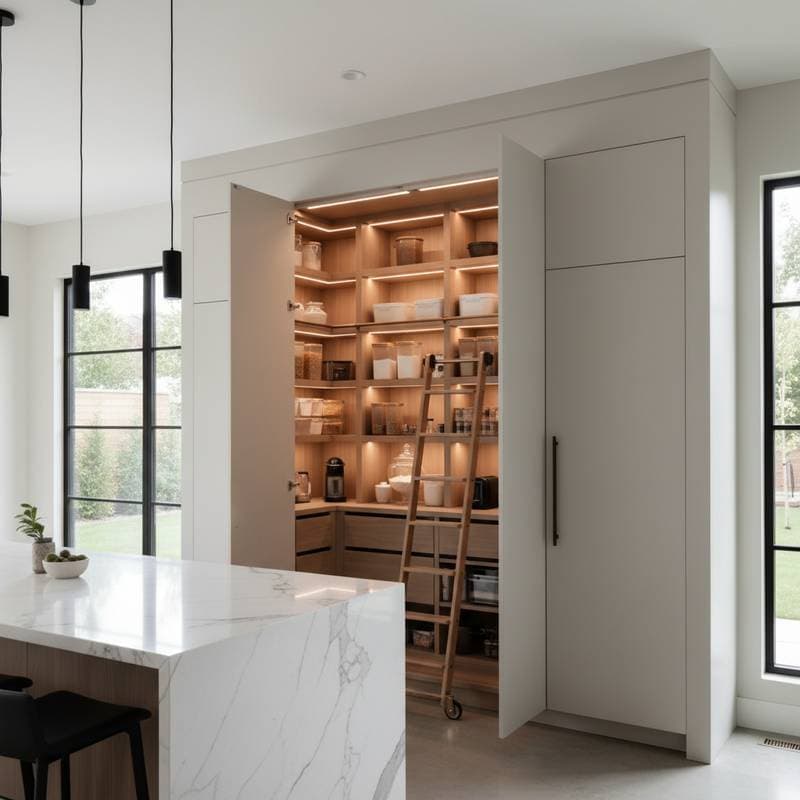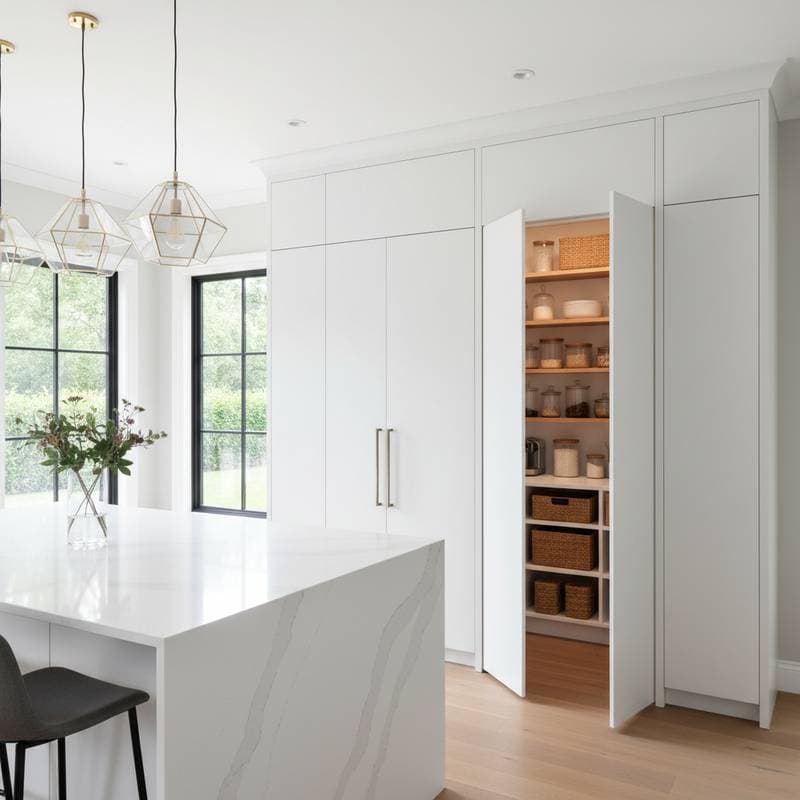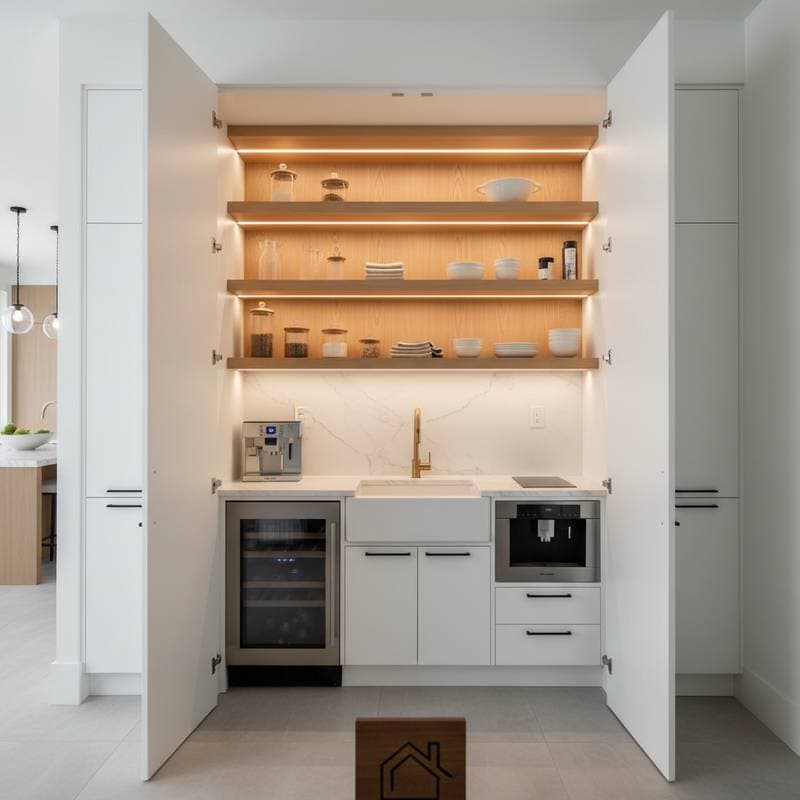How Hidden Pantries Increase Home Values by Up to 11 Percent
Key Insight: Incorporating or enhancing a hidden pantry can elevate your home value by as much as 11 percent. Prospective buyers appreciate kitchens that appear organized and spacious, and a hidden pantry provides ample storage without compromising visual elegance.
A hidden pantry consists of a walk-in or integrated storage area concealed behind cabinet panels, trim, or a door that matches the surrounding design. This feature stores bulk groceries, small appliances, and miscellaneous items out of view, preserving the kitchen's polished look. Among various home improvements, it stands out for delivering substantial returns with minimal disruption to the overall space.
Steps to Install a Hidden Pantry
1. Select an Optimal Location
Identify a wall adjacent to your primary food preparation zone. Corners or areas adjacent to laundry rooms or hallways often prove suitable. For a walk-in configuration, allocate a minimum of 3 feet by 5 feet. In compact kitchens, integrate a shallower pantry that aligns with the depth of existing cabinets.
Consider accessibility and traffic flow during this phase. Measure the space precisely to avoid encroaching on walkways or essential appliances. Consulting floor plans or using tape to outline the area on the floor helps visualize the final setup.
2. Choose an Appropriate Door Design
Align the pantry door with your cabinetry in terms of panel style, finish, and hardware. This seamless integration ensures the door blends invisibly into the kitchen facade. Opt for touch-latch mechanisms that eliminate visible handles, promoting a minimalist aesthetic.
Evaluate hinge types for smooth operation, such as soft-close hinges that prevent slamming. If the door swings outward, confirm it does not obstruct nearby drawers or pathways. For sliding options, select tracks that operate quietly and require minimal clearance.
3. Design the Interior Storage System
Incorporate adjustable shelving units, pull-out drawers, and dedicated bins to maximize organization. Position outlets strategically for appliances like toasters or mixers. Divide the space into zones: one for dry goods, another for utensils, and a section for less frequently used items.
Prioritize vertical space with tall shelves for large containers. Install lazy Susan turntables in corners to access items easily. Ensure the layout accommodates your household's specific needs, such as space for pet food or recycling bins.
4. Address Ventilation and Illumination Needs
Enclosed spaces like hidden pantries can accumulate heat and humidity from stored perishables. Integrate a subtle exhaust fan or passive vent to promote air circulation. Install LED strip lighting along shelves and the ceiling for clear visibility.
Motion-activated sensors prove effective, illuminating the interior only when needed and conserving energy. Select warm-toned bulbs to create an inviting atmosphere without harsh glare. Test the system during planning to confirm even light distribution.
5. Complete the Finishing Touches
Apply a durable, washable coating to the interior walls and shelves, such as semi-gloss paint or laminate. Verify the door alignment and operation for effortless access. Organize contents immediately to establish maintenance habits that sustain functionality.
Inspect for any gaps or uneven surfaces that could harbor dust. Add magnetic strips for utensil storage or hooks for bags if space permits. A final walkthrough ensures the pantry integrates harmoniously with the kitchen's daily rhythm.
Project Timeline
Hidden pantry installations typically span 1 to 3 weeks, depending on complexity.
- Planning and Material Procurement: 3 to 5 days
- Building and Fitting: 4 to 10 days
- Finalizing and Review: 2 to 3 days
Timelines shorten for projects that utilize existing wall structures. Modifications involving load-bearing elements or electrical additions extend the duration. Coordinate with contractors early to align schedules and minimize delays.
Essential Tools and Supplies
Gather these items to execute the project efficiently:
- Stud finder and spirit level
- Circular saw or jigsaw for precise cuts
- Drill with assorted bits
- Paints, stains, or sealants for surfaces
- Cabinet-grade plywood or medium-density fiberboard (MDF)
- Hidden hinges or push-to-open latches
- LED lighting strips and, if required, electrical outlet components
Prioritize safety by donning protective eyewear and gloves throughout. Engage a certified electrician for any new wiring to comply with building codes and ensure reliability.
Analyzing Return on Investment
Hidden pantries enhance property appeal through superior organization and design sophistication. Data from national remodeling studies indicate that kitchen upgrades featuring discreet storage yield among the top financial recoveries.
Expected ROI Ranges:
- Basic concealed storage addition: 8 to 10 percent
- Comprehensive walk-in pantry: 9 to 11 percent
For instance, a $10,000 investment could yield $9,000 to $11,000 in added market value, alongside improved everyday convenience. Factors like location and overall home condition influence these figures, but the consistent demand for functional kitchens amplifies the benefits.
Local real estate trends further support this: Homes with innovative storage solutions often sell faster and at premiums. Appraisers recognize the pantry's role in modernizing outdated layouts, making it a worthwhile consideration for long-term owners.
Expert Recommendations for Optimal Results
Maintain a flush alignment between the door and adjacent cabinets to avoid visual disruptions. Select interior materials that resist stains and simplify cleaning, such as melamine-coated shelving. Automate lighting to enhance user experience without manual intervention.
Place weightier objects on lower levels to promote stability and reduce strain during retrieval. Implement labeling systems for containers to streamline inventory management. If dimensions permit, incorporate a built-in countertop for minor food prep tasks, transforming the pantry into a versatile extension of your kitchen workflow.
Consider integrating smart features, like app-controlled lighting or inventory-tracking shelves, for tech-savvy households. Regular audits of contents prevent overcrowding, preserving the space's efficiency over time.
Frequently Asked Questions
What dimensions suit a hidden pantry?
A walk-in version requires at least 3 feet by 5 feet, while smaller setups match standard cabinet depths for constrained areas.
Is ventilation essential for hidden pantries?
Absolutely. Proper airflow mitigates risks of mold and odors from enclosed environments.
Can hidden pantries accommodate appliances?
Yes, with dedicated outlets and ventilation, they store items like microwaves safely and discreetly.
Implementing Your Hidden Pantry Upgrade
Hidden pantries merge utility with refined design, offering clutter reduction and elevated home equity. They empower residents to enjoy organized living while positioning the property favorably in competitive markets. Begin with accurate assessments, thoughtful planning, and selections that harmonize with your kitchen's character to realize these advantages fully.











